Telescope-Shopping, A Comet in Orion, the Bull Bellows Meteors, Glimpse a Globular near Saturn, and the Pretty Moon meets Venus with Maximum Mercury on Mid-week Mornings!
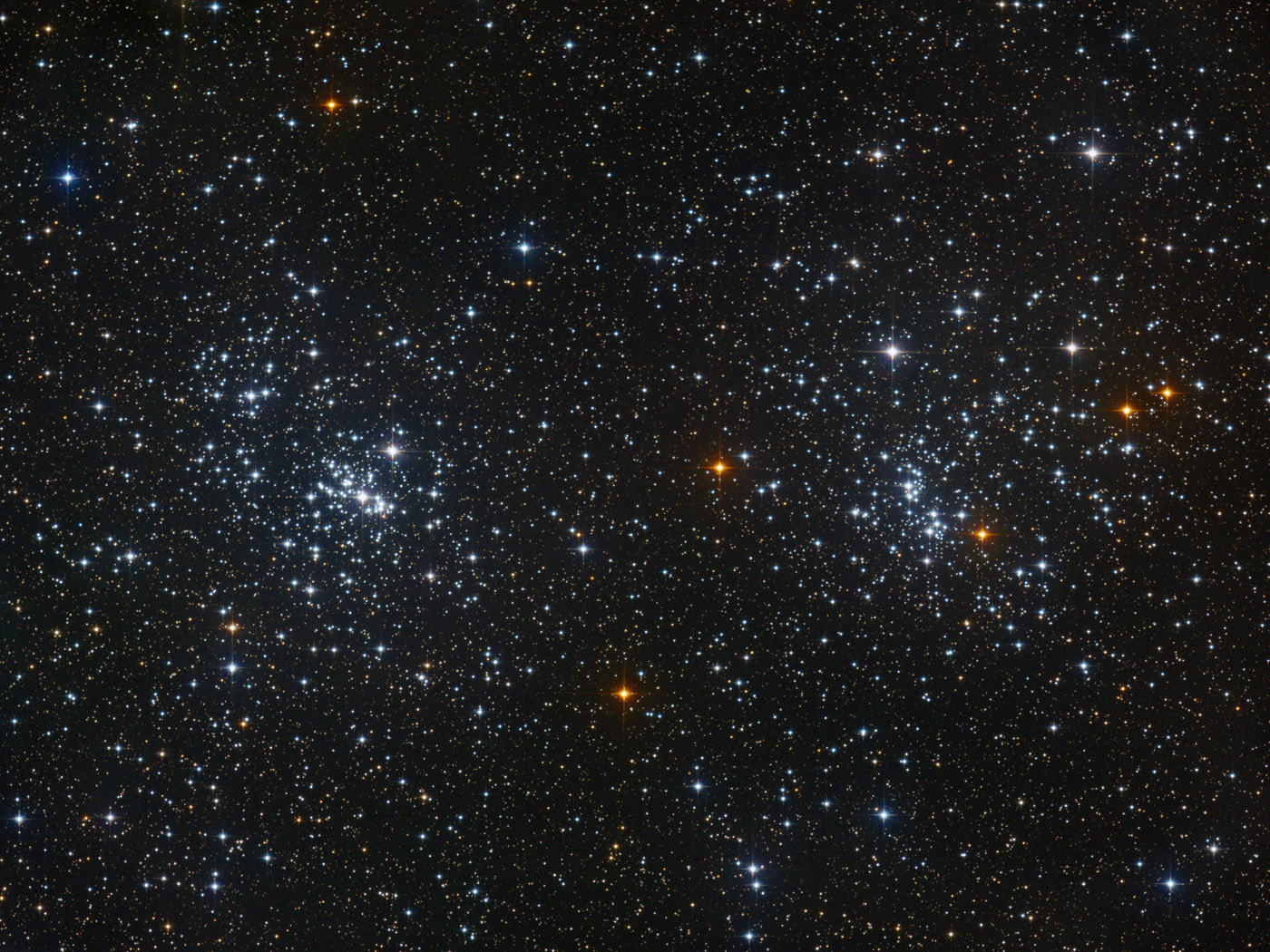
The Double Cluster, imaged here by Volker Wendel, is about 6,800 light-years away from our sun. The area shown spans about one degree, or a thumb’s width, of sky. NASA APOD for December 7, 2007
Hello, Dark-Sky Stargazers!
Here are your Astronomy Skylights for the week of November 8th, 2020 by Chris Vaughan. Feel free to pass this along to your friends and send me your comments, questions, and suggested topics. You can also follow me on Twitter as @astrogeoguy! Unless otherwise noted, all times are expressed in Eastern Time. To subscribe to these emails please click this MailChimp link.
I can bring my Digital Starlab portable inflatable planetarium to your school or other daytime or evening event, or teach a session online. Contact me through AstroGeo.ca, and we’ll tour the Universe, or the Earth’s interior, together!
It’s telescope-shopping season, and I offer some advice around that. The moon’s visit with Venus and Mercury in the eastern pre-dawn sky will leave evenings darker worldwide – perfect for viewing Taurids meteors, Comet Atlas in Orion, and other deep sky delights. Mars continues its splendid all-night showing – with Uranus and Neptune nearby – but Jupiter and Saturn will only be observable during early evening. Read on for your Skylights!
Telescope Buying Tips
Quite a few people have asked me about buying a first telescope. Before you shop, or ask an expert for advice, consider these questions: What kinds of objects do I want to view? Does it need to be portable? Do I want to photograph the sky with the telescope – now or eventually?
Two of the most important characteristics in telescope performance are its aperture (the diameter of the main “tube”) and the sturdiness of the mount/tripod. The aperture corresponds to the diameter of the main mirror or lens in the telescope – and the larger it is, the more light it can gather, allowing fainter objects to be seen more easily. A larger aperture also increases the telescope’s angular resolution, or sharpness, which is especially helpful for planets.
In a refractor telescope (the type with the lens at the front end of the main tube), look for a minimum diameter of 80-mm. This type of telescope will offer nice views of the brighter planets, the Moon, double stars, and brighter nebulae, clusters, and galaxies (such as the Andromeda Galaxy). The performance of a telescope improves with the square of the aperture, so an 80-mm telescope is (80*80)/(60*60) = 1.8 times more powerful than a cheaper, 60-mm department store telescope! That’s nearly double the light-gathering ability!
In reflector telescopes (the type with the large mirror inside the bottom of the main tube), diameters of 6 or 8 inches (150-mm to 200-mm) are common and affordable. Because of the aperture scaling rule, they outperform refractor telescopes by letting you view dimmer galaxies and clusters, especially under a dark sky, while also showing the same brighter objects. (An 8-inch reflector gathers more than six times as much light as an 80-mm refractor!)
The second important factor when shopping is the mount, including the tripod. A high quality telescope on a rickety mount is practically useless. Every time you touch it, for focusing or centering an object, you set off wild shaking of the image. This is one of the main reasons why cheap department store telescopes are poor investments – people get frustrated when they can’t put objects in the field of view and keep them there.
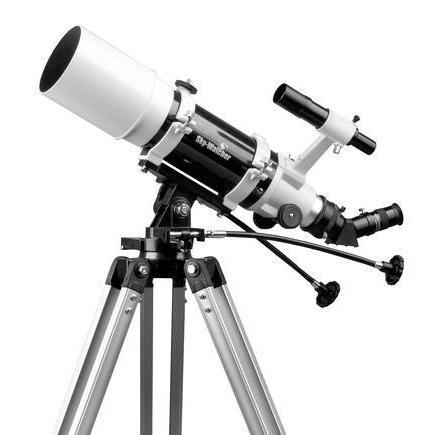
Here’s a 102-mm diameter refractor that ticks all the boxes for me in terms of optics, tripod, and accessories – the Sky-Watcher StarTravel 102 AZ3 refractor. It has a lower focal ratio (f/4.9) that yields a wider view of the sky, making finding objects easier, and it has achromatic optics to reduce colour fringes from bright objects. It lists for CDN $420 from many vendors, e.g., https://kwtelescope.com/startravel-102-az3/, https://khanscope.com/collections/sky-watcher-usa/products/sky-watcher-startravel-102-az3-telescope-s10100, https://maisonastronomie.ca/product/f-refracteur-102-az3/, and https://focusscientific.com/product_info.php/products_id/542.
The “AZ3” mount is a good, lightweight, and sturdy tripod that includes slow motion controls for following the object as the Earth turns. Sky-Watcher sells a larger aperture version of this telescope, too. Any other brand with similar specifications should be okay, too.
The type of telescope I recommend most for beginners is the Dobsonian–mounted reflector. While larger and heavier, Dobsonians are simple and easy to set up and use. They are less portable, but are quite rugged, and can be transported in the trunk of your car if pad them decently. The beauty of the Dobsonian design is the extremely sturdy mounting system – not a tripod, but a swivelling and tilting box that holds the big tube. Once aimed at a target, a simple nudge with your finger will re-centre the object without any undue shaking. These types of telescopes typically show a generous amount of sky in the eyepiece, making finding targets much easier. Here are some links for Dobsonian reflectors. The 6” Dobsonian lists for CDN $430 at https://kwtelescope.com/classic-150p-dobsonian/. The 8” Dobsonian lists for CDN $610 at https://kwtelescope.com/classic-200p-dobsonian/ and at http://www.durhamskies.com/SkyWatcher-8-Traditional-Dobsonian_p_13.html

While computerized telescopes are terrific, I dissuade beginners from buying these pricier systems until they’ve learned the major elements of the sky. These GOTO systems can slew to an object for you – but if you don’t know how to align them, and where to find the target in the sky in the first place, then how will you trouble-shoot them if you can’t see anything through the eyepiece? If you do want to jump in, consider a Schmidt-Cassegrain Telescope (SCT). These combine lenses and mirrors into a smaller, stubbier tube, and are very portable. The Celestron Nextar line of telescopes are available just about everywhere: https://kwtelescope.com/nexstar-6se-sct/ The 6-inch diameter Celestron Nexstar 6se lists for CDN $1100. Note that you’ll need a continuous power system (12V battery pack or AC adapter) for any Go-to telescope system.
An alternative to the computerized telescope is the new Celestron StarSense Explorer line. These ones use a smartphone holder and a mirror mounted on a beginner telescope to help you find sky objects – even dimmer, hard to find from the driveway targets. I haven’t used one myself, but the reviews I’ve seen are very positive. Their page is https://www.celestron.com/collections/starsense-explorer-smartphone-app-enabled-telescopes
Try to avoid buying inexpensive telescopes from department stores or on Amazon. They tend to use plastic parts easily broken – especially during winter when plastic gets brittle. Some of the best southern Ontario telescope vendors include Durham Skies, Ontario Telescope, KW Telescope, and Khan Scope. If you live in the USA, consider B&H Photo. Many of these vendors offer both new and used equipment, which can be a very cost effective solution. Used Dobsonians in particular can be found on sites like Kijiji and the Canadian astronomy selling site Astrobuysell, mainly because people find them harder to store. Typical prices for good, used telescopes range from $250 to $500. If you are buying used, make sure that you try out the telescope on a star – to ensure that you can achieve a sharp pinpoint focus. (And use caution when engaging in cash transactions with strangers, as well as social distancing precautions.)
One last tip – the eyepieces do the job of magnifying. So look for telescopes that accept eyepieces with 1.25” diameter barrels – the standard for quality equipment. That way you can add extra eyepieces, or upgrade to better quality ones later. You can mix brands if the barrel size matches your telescope. The useful range of magnification in a typical backyard telescope is 40x to 250x. If the sky conditions are very steady, you can push that to 300 to 400x. The “power” or “times, x” is calculated by dividing the telescope’s focal length by the eyepiece focal length, which is usually prominently labelled on the eyepiece.
The Sky-Watcher refractor I mentioned above has a 500-mm focal length, which shows you a nice wide patch of sky. It comes with 10-mm and 25-mm focal length eyepieces that will yield 50x and 20x, respectively. You’ll find the planets are look wee bit small, even at 50x, so consider buying a 5-mm (or thereabouts) eyepiece. The Sky-Watcher 8” (200-mm) aperture Dobsonian has a focal length of 1200-mm, and comes with the same two eyepieces, which will provide you with generous magnifications of 120x and 48x.
Here’s an online beginner telescope buying guide from the Backyard Astronomer’s Guide folks.
More Meteors from Taurus
Last week, the Southern Taurids Meteor shower peaked. This week, it’s the Northern Taurids turn. Why? Because the debris dropped by periodic comet 2P/Enke has become split into two separate zones. Earth traverses the densest region of each zone about one week apart – producing two separate showers at this time of year. Meteors from the Northern Taurids shower, which appear worldwide from October 19th to December 10th annually, will reach a peak of about 15 meteors per hour on Thursday, November 12. The larger-than-average grain sizes of comet Enke’s particles often produce colorful fireballs.
Although Earth will be traversing the densest part of the comet’s debris train during mid-day in the Americas, the best viewing time will occur hours earlier, at around 1 am local time. At that time, the shower’s radiant, located in central Taurus, will be high in the southern sky. But don’t watch the radiant – meteors near it will have very short streaks because those meteors are traveling directly towards you. Instead, find a safe, dark location with lots of open sky, get comfortable, and just look up. Don’t bother chasing meteors with binoculars or a telescope – those instruments have a field of view that is too narrow.
On the peak night, a waning crescent moon won’t rise until around 4 am local time, leaving the sky nice and dark for meteor watching during the middle of the night. If your weather forecast predicts clouds on the peak date, you can expect to see fewer Taurids on the surrounding nights. While you are looking up, keep an eye out for early meteors of the Leonids shower, which will peak on November 17. Leonids will appear to be traveling from east to west across the sky.
The Moon
During the coming week, the moon’s phase will transition from last quarter to new. That means that our celestial night-light will be rising between midnight and dawn, leaving evening skies all around the world deliciously dark for viewing the best of the late-autumn and early winter constellations – before the bitter temperatures arrive. I’ll highlight some objects below.
Today (Sunday) the moon will officially reach its last quarter phase at 6:45 pm Eastern Standard Time (or 13:46 Greenwich Mean Time). When it rises at about midnight, its half-illuminated face will sit among the stars of Leo (the Lion) – not far from that constellation’s brightest star, Regulus. Notice that I said that the moon will reach its phase many hours before it rises. Moon phases have no connection to the rotation of Earth.
The moon will culminate, or reach its highest point in the sky, over the southern horizon, at sunrise. Then it will continue traveling across the western sky in daylight, until it sets in early afternoon. You’ve all seen the moon in the daytime. You can use your binoculars and telescopes on a daytime moon, too – as long as you never point them anywhere near the sun. To make the ghostly moon look clearer in the eyepiece, try wearing non-darkening polarized lenses (such as 3D glasses from the movies), and rotate them until the sky around the moon looks darkest.
From Wednesday through Friday this week, the waning crescent moon will traverse the large constellation of Virgo (the Maiden) while also visiting the bright planet Venus in the eastern pre-dawn sky. Their scene will make a pretty sight and offer some terrific photo opportunities.
On Wednesday morning, the crescent moon will rise at about 2:30 am local time and then sit two fist diameters above Venus until dawn. On Thursday morning, the moon will descend to sit a palm’s width above (or 6 degrees to the celestial west of) Venus – making a lovely photo opportunity when composed with some interesting scenery. On Friday morning, the delicate, crescent moon will sit above Mercury and below much brighter Venus. Look for Virgo’s brightest star Spica, sitting off to the moon’s right, and the very bright, orange star Arcturus way off to their upper left. That grouping will make another lovely photo opportunity.
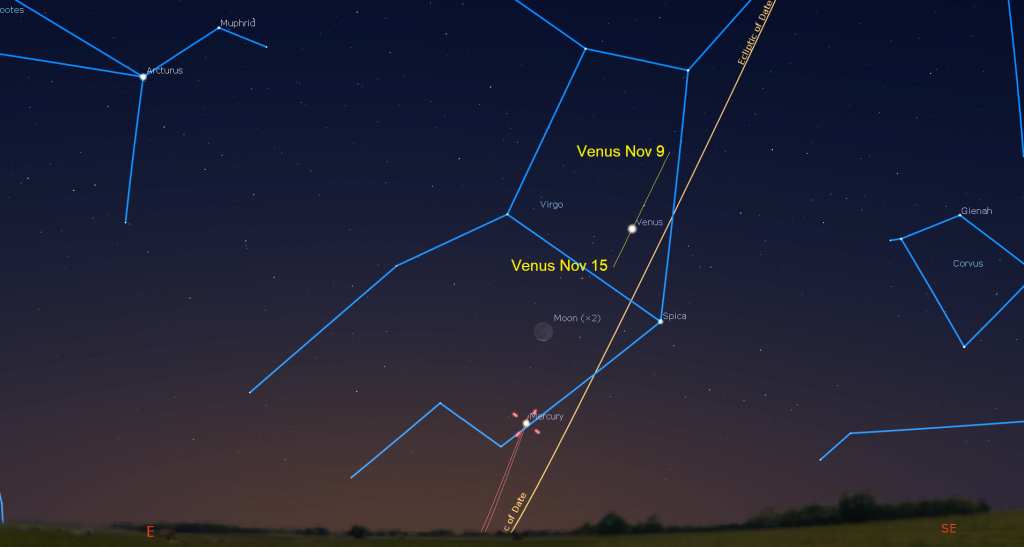
Friday morning will bring our last chance to see the old moon – now positioned well below Mercury – for about half an hour before dawn. New moon will officially occur at 12:07 am EST, or 5:07 GMT on Sunday. At its new phase, the moon is travelling between Earth and the sun. Since sunlight can only reach the far side of the moon, and the moon is in the same region of the sky as the sun, the moon becomes completely hidden from view. This new moon, occurring only 17 hours after perigee (the moon’s closest approach to Earth), will trigger large tides around the world.
The Planets
Very bright, white Jupiter will become visible in the lower part of the southern sky after about 5:30 pm local time this week. A short time after that, dimmer, yellowish Saturn will appear to Jupiter’s upper left (or 4.5 degrees to the celestial east). Faster Jupiter is chasing slower Saturn, and they’ll pair up in spectacular fashion on December 21! Our season of good telescope views of those two planets is almost over. After 7 pm in your local time zone, they will be getting low in the southwestern sky, and shining through a much thicker blanket of Earth’s atmosphere. You might even see them twinkle a little bit before they set! Thankfully, the earlier sunsets have allowed us to start viewing them earlier each night.
Good binoculars should show you the four large Jupiter moons that Galileo Galilei discovered in January, 1610. Named Io, Europa, Ganymede, and Callisto, they dance around the planet from night to night – although one or more can be hidden by Jupiter at any given time. If the air is steady, even a modest-sized telescope will show Jupiter’s brown bands and the famous Great Red Spot (or GRS, for short). Due to Jupiter’s 10-hour rotation period, the GRS will be visible every second or third night at your location on Earth. In the Eastern Time zone, the Great Red Spot will be crossing the planet’s disk after dusk on Monday, Thursday, and Saturday.
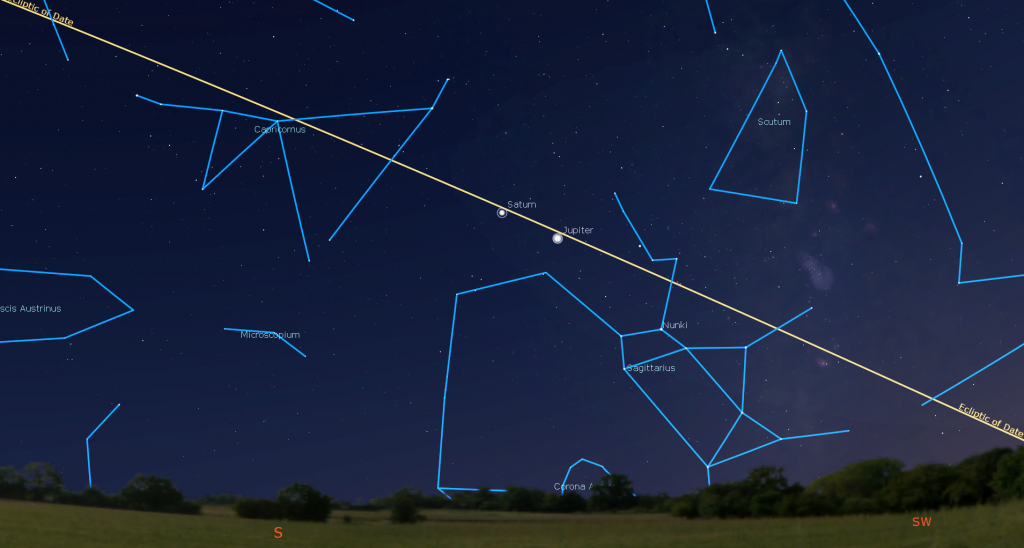
From time to time, the round, black shadows cast onto Jupiter by its Galilean moons are visible in amateur telescopes as they cross (or transit) the planet’s disk for a few hours. On Monday, November 9 from 4:40 pm (dusk in the Eastern Time Zone) to 6:50 pm EST, Io’s small shadow will cross Jupiter. On Saturday night, November 14, Europa’s shadow will cross between 6 pm and 8:50 pm EST. The planet will set in the Eastern Time Zone before the transit has finished, but observers who live in mid-continent can see the entire event. The events will be visible anywhere on Earth where Jupiter is above the horizon during the time windows (adjusted to your local time zone). Other places will see different transits. For example, if you live in Western Canada or the continental USA, a good Ganymede shadow transit will occur after dusk on Sunday night.
Saturn is a spectacular sight. Any backyard telescope will show you Saturn’s rings. See if you can see the Cassini Division. It’s the narrow, dark gap that separates Saturn’s main inner ring from its outer one.
Your telescope should also reveal several of Saturn’s moons – especially its largest, brightest moon, Titan! Because Saturn’s axis of rotation is tipped about 27° from vertical (a bit more than Earth’s axis), we are seeing the top surface of its rings – and its moons can arrange themselves above, below, or to either side of the planet. The trick for seeing more moons is to watch continuously for a minute or two, and let the dimmer, closer-in moons appear in those moments when the air stabilizes. During evening this week, Titan will migrate counter-clockwise around Saturn, moving from the left of Saturn tonight (Sunday) to the right of the planet next Sunday. (Remember that your telescope might flip the view around.) Fun fact: There’s a Lake Ontario on Titan!
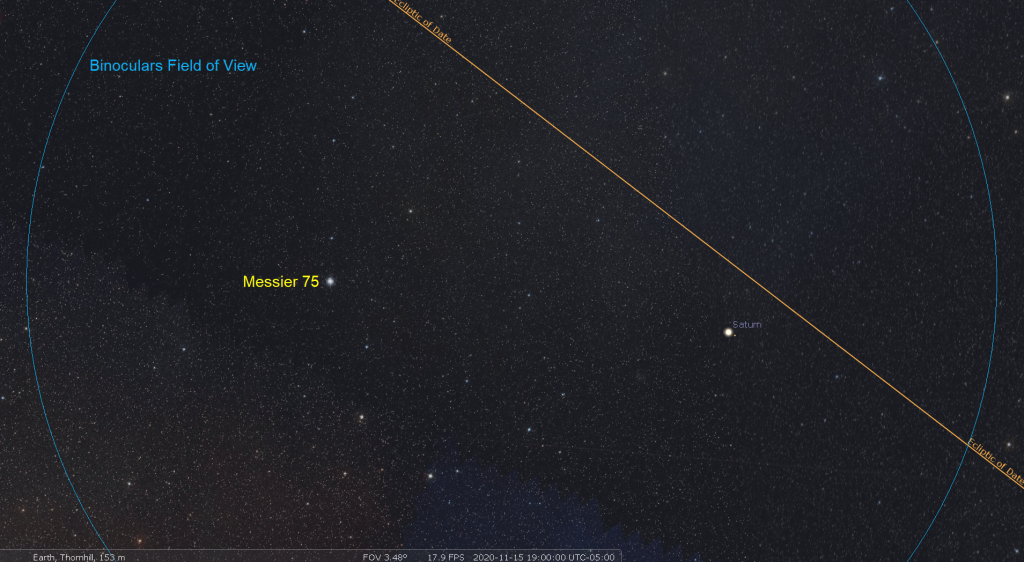
Back in June and July, when they were moving retrograde westward, Jupiter and Saturn passed close to a globular star cluster named Messier 75 (or M75). Now that the two planets have resumed normal eastward motion, they are going to pass that cluster again. This week, in binoculars or telescopes, look for a faint fuzzy patch located about two finger widths to the upper left (or 3 degrees to the celestial southeast) of Saturn. Next week, Saturn will be even closer to M75 – but by then the bright moon will have returned to the western sky.
Thankfully, Mars is still a great evening and late-night target! This week, bright, reddish-tinted planet will already be shining in the lower part of the southeastern sky after dusk. Mars will climb to its highest point – and best viewing position, a bit more than half-way up the southern sky – at about 10 pm local time. Then it will set in the west before sunrise.

Viewed in a telescope this week, Mars will display the dark, wedge-shaped Syrtis Major region and the dark Mare Erythraeum and Sinus Sabaeus regions, and the bright, adjacent Hellas and Aeria regions. A good Mars mapping tool is here. Note that it flips the planet to match a typical telescope. You’ll need to know the Universal Time (UT) that corresponds to the local time when you are viewing the planet. In the Eastern Time Zone, 02:00 UT equals 9 pm EST.
Because Earth is passing Mars on the “inside track” of the solar system, Mars has been moving retrograde, causing the planet to appear to travel westward compared to the narrow “V” of modest stars at the bottom of the constellation of Pisces (the Fishes). That westerly motion ends next Sunday. You won’t see the change unless you carefully note the positions of Mars and the surrounding stars changing over several nights.
Blue-green Uranus is still a fine target because it reached opposition and best visibility for 2020, only a week ago. Uranus is among the stars of southern Aries (the Ram) – a fist’s diameter below and between Aries’ two brightest stars Hamal and Sheratan. For context, that region of the sky is two fist diameters to the left (or 22° to the celestial east) of Mars. At magnitude 5.7, Uranus is within reach of backyard telescopes, binoculars, and even some sharp, unaided eyes – while the moon is away. Try for Uranus after mid-evening, when it will be higher in the sky. I posted a detailed star chart for Uranus here.
Deep blue Neptune is located about 2.7 fist diameters to the lower right of Mars – among the stars of northeastern Aquarius (the Water-Bearer) and about two finger widths to the left (or 2 degrees to the celestial east) of the medium-bright star Phi Aquarii or φ Aqr. This week, dim and distant planet will already be in the lower southeastern sky after dusk. Then it will climb higher until 8 pm local time, when you’ll get your clearest view of it while it’s almost halfway up the southern sky. I posted a detailed sky chart for Neptune here.
Venus has been gleaming in the eastern pre-dawn sky for some time now. It will rise at about 4:15 am local time this week, and then remain visible in the eastern sky until sunrise while it is carried higher by the rotation of the Earth. Viewed in a backyard telescope, Venus will show a gibbous, football shape. This week, the planet will be traveling through the stars of Virgo (the Maiden) – to the upper left of that constellation’s brightest star Spica. As I mentioned above, watch for the pretty, crescent moon’s visit mid-week. Venus is shifting towards the sun – but the later sunrises at this time of year will allow it to shine in a dark, pre-dawn sky until early December!
For Northern Hemisphere observers, this week will offer your best opportunity of 2020 to see Mercury in the eastern pre-dawn sky; but it will be a poor apparition for those located near the Equator and farther south. On Tuesday, Mercury will reach a maximum angle of 19 degrees from the sun, and peak visibility for this morning apparition. Look for the swiftly-moving planet shining brightly very low in the east-southeastern sky, below and a bit to the left of Venus, between about 5:45 and 6:30 a.m. in your local time zone. In a telescope (inset) Mercury will exhibit a 58%-illuminated, waxing gibbous phase. Be sure to put binoculars and telescopes away well before the sun rises!
Binocular Comet in Orion
This week, a comet named C/2020 M3 (Atlas) will be passing north through Orion (the Hunter) – so it will be observable after mid-evening! At the present time, the comet is shining at a modest magnitude 8 – putting it within reach of binoculars and amateur telescopes while the moon is away. Comet Atlas has already peaked in brightness, and will rapidly dim in the coming weeks.

Tonight (Sunday) the comet will be located very close to (8 arc-minutes west of) the medium-bright star Eta Orionis, which sits about two finger widths to the right of the bright star Mintaka, the highest star in Orion’s Belt. On each subsequent evening the comet will rapidly travel to the upper left (or celestial north) – ending this week close to the bright star Bellatrix, Orion’s western shoulder.
The comet should appear as a faint fuzzy star, possible with a greenish hue. If it has a tail, that will be pointed roughly away from Orion’s belt. I’ll post a finder chart for this week here.
Deep Sky Delights for November
Here are some terrific deep sky objects to view during this moonless week.
During mid-evening in November, the Andromeda Galaxy is positioned nearly overhead – perfect for viewing through a minimum of Earth’s atmosphere. An all-night target, this large spiral galaxy, also designated Messier 31 (or M31), is only 2.5 million light years away from us, and subtends an area of sky measuring 3 by 1 degrees. When facing east, the galaxy can be seen with unaided eyes as a faint smudge located about 1.4 fist diameters to the left (or 14 degrees to the northeast of) the square of Pegasus (the Flying Horse). The three westernmost stars of Cassiopeia (the Queen), Caph, Shedar, and Navi, also conveniently form a triangle that points downwards towards M31. Binoculars will reveal the galaxy better. In a telescope, use low magnification and look for M31’s two smaller companion galaxies, the foreground Messier 32 and more distant Messier 110.
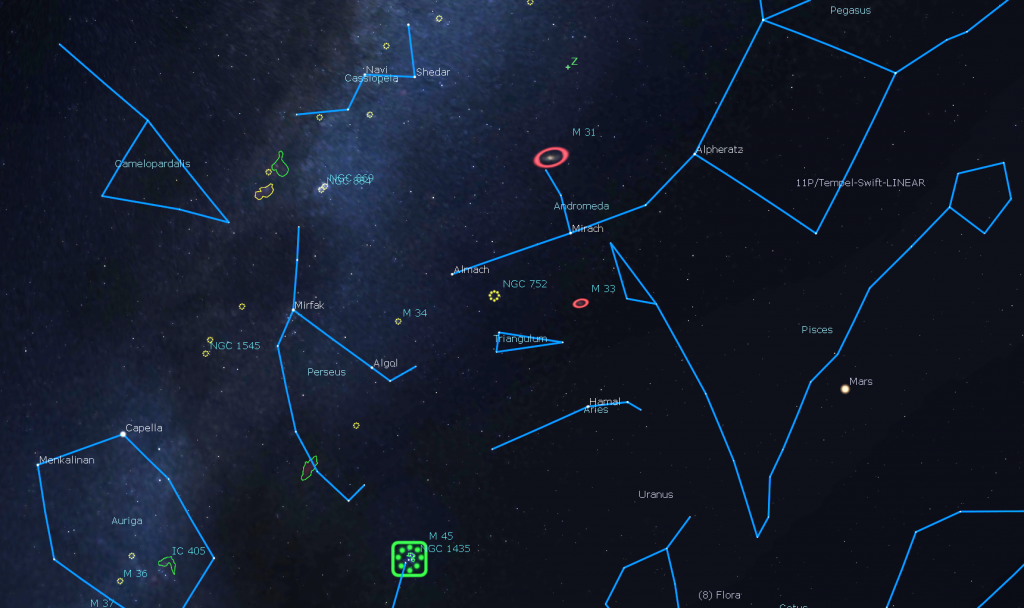
For more of a challenge, the Triangulum Galaxy, also known as Messier 33 and NGC 598, is a large, nearly face-on, SA-type spiral galaxy located 2.8 million light-years away from us. M33 is located 1.4 fist diameters below M31, close to the western edge of the constellation of Triangulum. That puts it a generous palm’s width below (or 7 degrees southeast of) the bright star Mirach (Beta Andromedae). Under very dark sky conditions, some sharp-eyed observers have been able to see this low surface brightness member of our local galaxy group, making it the farthest object detectable by the unaided human eye. Binoculars and long-exposure images reveal that the galaxy subtends an angle of 1 x 0.66 degrees (or two by one full moon diameters), with the long axis approximately left-right.
On the border between Perseus (the Hero) and Cassiopeia (the Queen) sits the well-known Double Cluster. These two bright, open star clusters, each nearly a full moon in diameter and approximately 1.5 moon diameters apart, form a spectacular sight in binoculars or telescope at low magnification. The higher, more westerly cluster, also known as NGC 869 is more compact and contains more than 200 white and blue-white stars. NGC 884, the lower, easterly cluster, is slightly more spread out. The clusters reside in the Perseus Arm of the Milky Way and are located about 7,300 light-years from the sun. Their region of the sky is heavily loaded with opaque interstellar dust that suppresses their intensity.
While you’re looking at these objects, pan around for more treats. The outer rim of our Milky Way runs through Auriga (the Charioteer), Perseus, and Cassiopeia, populating them with many clusters and nebulas.
The Brightest Stars of November
If you missed last week’s tour of the brightest evening stars, I posted it, with star charts, here.
Public Astro-Themed Events
Every Monday evening, York University’s Allan I. Carswell Observatory runs an online star party – broadcasting views from four telescopes/cameras, answering viewer questions, and taking requests! Details are here. Their in-person Wednesday night viewing has been converted to online via the observatory Youtube channel, where they offer free online viewing through their rooftop telescopes, including their new 1-metre telescope! Details are here.
On Wednesday evening, November 11 at 7:30 pm EDT, the RASC Toronto Centre will live stream their monthly Recreational Astronomy Night Meeting at https://www.youtube.com/rasctoronto/live. Talks include the Sky This Month, and talks about telescope-making and SkyShed Pods. Details are here.
My free, family-friendly Insider’s Guide to the Galaxy webcasts with Jenna Hinds of RASC National will return on Tuesday, November 17 – when we’ll talk about meteor showers and meteorites. (Send us suggestions!) You can find more details, and the schedule of future sessions, here and here. Don’t forget to tune in to Jenna and John Reid’s final RASC Explore the Universe certificate livestream on Thursday, October 29 at 3:30 pm EDT.
Keep looking up, and enjoy the sky when you do. I love questions and requests. Send me some!